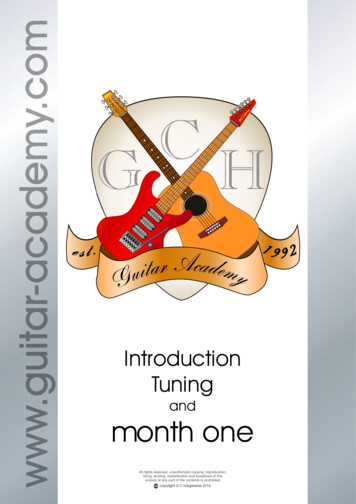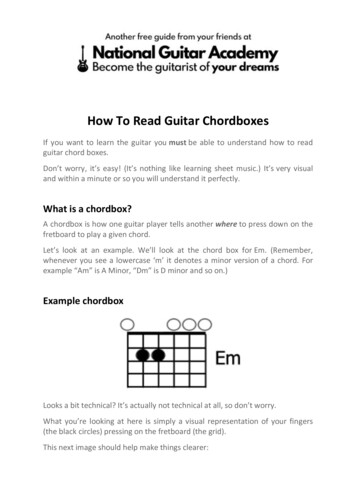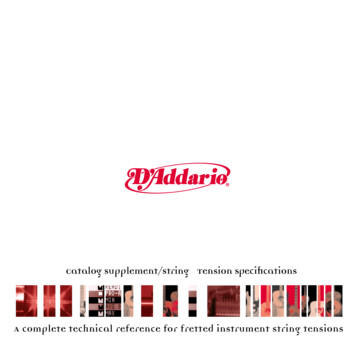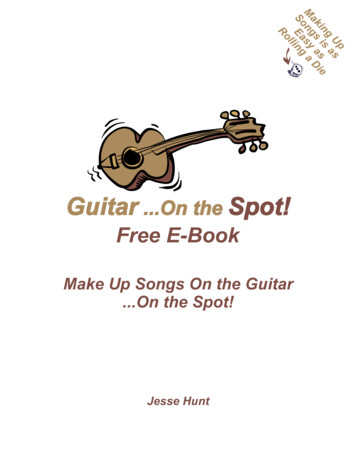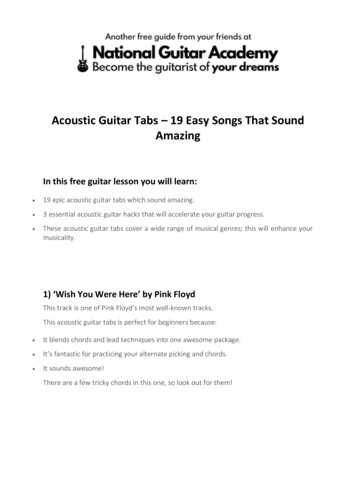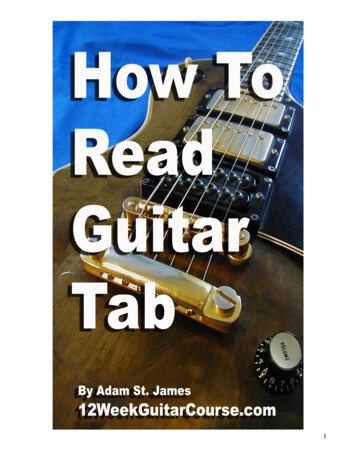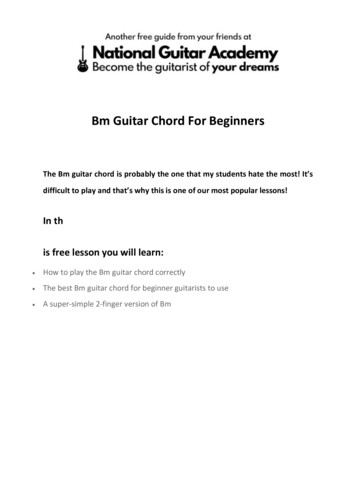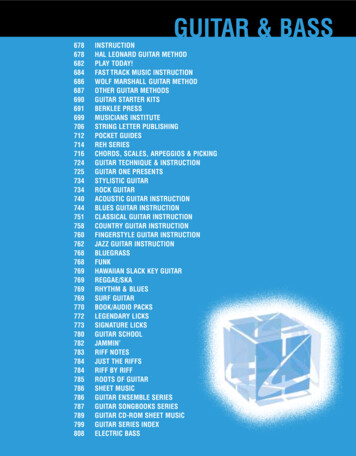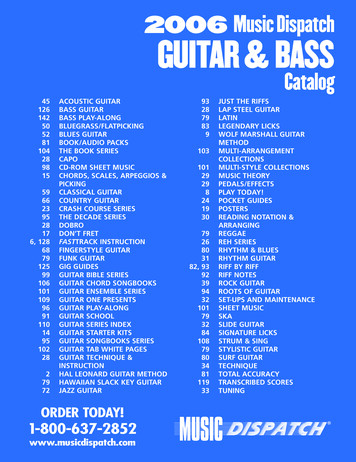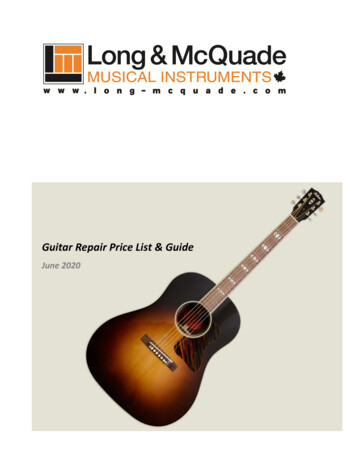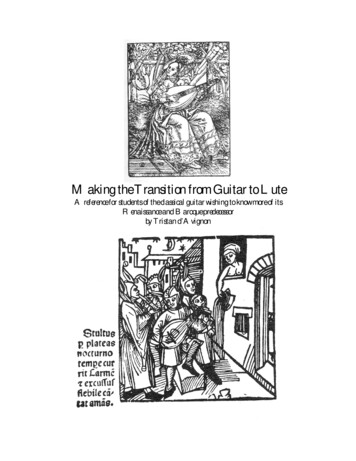
Transcription
Making the Transition from Guitar to LuteA reference for students of the classical guitar wishing to know more of itsRenaissance and Baroque predecessorby Tristan d’Avignon
ContentsIntroductionWhy Play the Lute?Basic Construction of a Renaissance LutePurchasing a LuteSetup and TuningThe Left HandThe Right HandTablatureGeneralitiesSpanish Vihuela TablatureFrench Lute TablatureItalian Lute TablatureCifra Nueva TablatureGerman Renaissance Lute TablatureOrnamentation and GracesModern ReadingsGreat! Where Do I Go From Here?ConclusionBibliographyAttributions of Musical Examples 2006 Tristan d’Avignon. Freely distributable for the purposes of the SCA.55567889910121315161718191919
Making the Transition from Guitar to LuteA reference for students of the classical guitar wishing to know more of its Renaissance and Baroque predecessorby Tristan d’AvignonINTRODUCTIONThere are many and varied reasons for the unwillingness of many performance classicalguitarists to take the next logical step into lute performance. It is true that the market forlutes is still very small, and that the cost of even a second‐hand lute can be very daunting. Itis also true that learning music for the lute requires adapting to a whole new style of notation.However, I feel that such reasons are not adequate to fully account for the lack of mainstreamunderstanding of this wonderful instrument, and I feel that more must be done to encouragescholarship in it.It is thus my intention, with the authoring of this paper and subsequent articles, to promoteunderstanding of the lute, its music and its rhetoric, as a viable extension to the theory andpractice of the modern guitar. Here, I will present as concise and as comprehensive a guideto the Renaissance lute as possible, such that any classical guitarist that reads it will have abasic understanding of the techniques and methods involved in playing the lute, and willperhaps take more of an interest in the lute in the future.WHY PLAY THE LUTE?The basic reason that I was particularly drawn to the lute initially was the astonishingamount of extant, yet somehow almost universally ignored, repertoire for the instrument.Being so closely aligned to the guitar, I should have thought that transcriptions into guitarmusic and/or tablature were readily available, but this was not the case. My hope is thatsomeone in the near future will be willing to take up the challenge and begin publishingmodern transcriptions of lute music for the guitar, in an effort to bring around 200 years’worth of repertoire back into the mainstream for guitarists.But ultimately it was the characteristic sound of the lute that won me over. Richard Barnfieldonce praised the lute as the instrument of Phoebus, the Queen of Music, and that it could“ravish human sense”. Indeed, in the hands of a skilled performer, the lute carries a far moredistinct and pure sound than that of the guitar; a kind of sound which possesses a warmthand romance all of its own. I cannot adequately describe to you the emotions that wereconjured up within me upon listening to a live lute performance, but afterwards I determinedthat this was the direction I wanted to be heading in.There is no denying that the lute is an underappreciated instrument in this day and age, andthat it is not yet adequately promoted to the mainstream musician. I hope that my effortshere will go some way towards amending this sad state of affairs.BASIC CONSTRUCTION OF A RENAISSANCE LUTEThe Renaissance lute evolved from the Moorish ‘ud, which had been introduced into Spainduring the 700s. A number of Spanish and Byzantine carvings from around the 10th centuryshow an instrument very similar in construction to the lute being played by Arab musiciansusing a large plectrum. It is likely that the lute first became popular in Europe during theHoly Crusades of the Middle Ages, and then undertook its own evolutional course in thehands of European musicians, separate to that of the ‘ud.Featured on the next page is a sketch of a standard six‐course lute, and its various importantparts.5
Fig. 1It is easy to see why the lute is the natural predecessor of the guitar, as all of the featureslisted in this diagram have guitar equivalents. There are only four major points of difference: The lute is a much smaller and lighter instrument, with a bowl‐shaped back, but witha wider fingerboard, which many guitarists may find disconcerting at first. The pegbox is bent backwards to retain tension in the gut strings. Five of the six courses shown here are double‐strung. This is entirely optional, andany or all of the courses may be “double” or “single” according to the preference ofthe player, but this setup is considered standard. The frets are editorially numbered from “b” to “i” instead of 1 through 8 as theywould be on a guitar; I shall explain this in greater detail in the “Lute Tablature”section.PURCHASING A LUTEThe first issue – often the most difficult – is the purchase or acquisition of a suitableinstrument. Lutes are nowhere near as common in today’s musical marketplace as theclassical guitar, and are still unreasonably expensive, even at second‐hand level. It iscertainly a wise idea to buy second‐hand for your first lute, but remember to bear in mind thefollowing things: Ask the seller if the tuning pegs are firm and will not unwind under normal pressure.If they do unwind, ask if there is a trick to them, such as pushing the pegs into theneck to stop movement. Ask if the frets are made of gut. This is important, as a loose or unsuitable fret mayresult in buzzing of the strings.6
Ask if the frets are firmly in place. This can also result in string buzz, and a veryloose fret can also be dislodged by the left thumb during performance.Ask about the framework in general: its weight and feel, its bodywork, and whetheranything at all is missing or broken. If you decide to buy a slightly damagedinstrument, you should be prepared to fix it yourself, or to find someone who can.Ask for a comprehensive series of digital photos of the instrument from severaldifferent angles, to back up their description of the instrument and its currentcondition. In today’s digital world, proof‐checking is much easier than it used to be,and there is no harm at all in verifying that the instrument is well‐conditioned, not tomention proofing yourself against a dishonest seller.If in doubt, don’t risk it! A lute is a very pricey investment at any level, and it isimportant to find an instrument that is well‐made and well‐kept, such that you maycontinue using it for years to come.SETUP AND TUNINGOne of the many bonuses for a lutenist is that they may select any number of setups whichconform to their needs most closely. Although no medieval lutes survive to this day, it isbelieved that they were typically constructed with four or five courses, and were played witha plectrum in the right hand. In the Renaissance, the standard was six courses, and theinstrument was then played with both hands, using the thumb‐under technique. By the lateBaroque, there are instances of lutes being made with as many as fifteen courses, with thestrings below the standard six – the diapasons – commonly used for low bass notes, whichwere commonly played using the thumb‐over technique. Any setup between six and fifteencourses is possible, and the performer should choose that which suits them best. For theperformer already skilled in the classical guitar, the standard six‐course Renaissance lute isthe obvious choice for a simple and immediate transition. Hence, this setup is assumed in allcases for the purposes of this paper.There are numerous ways to tune the six‐course lute according to the preference of theperformer, but the current convention is to have the open courses resonate at the followingpitches, from lowest to highest: G‐c‐f‐a‐d1‐g1. Most lute music of the Renaissance era iswritten to match these intervals. Guitarists should note that the major third in the tuningpattern is here found between the third and fourth courses, rather than the second and thirdas it occurs on a standard‐tuned classical guitar.1 This may result in some early confusion,and perhaps some interesting chords if reading from notation, but ultimately, most guitaristsmaking the transition to lute will find little challenge in adapting their chord fingering to suitthe music.The seated playing position for the lute is much more compacted and balanced than for theguitar, as the instrument is much lighter, and may be prone to rolling backwards if notcorrectly held. The student must be careful not to place any weight directly on theinstrument with the arms as they might with a guitar, and to position the instrument in theirlap in such a way that they can still look across to view their chord fingering if necessary. It isalso acceptable for the student to use a table to rest the lute on while playing, as this is adocumented practice of the time.2For guitarists with limited or no access to a lute, their classical guitar only requires the thirdstring to be tuned down from g to f# to act as a substitute. When playing lute music on aclassical guitar using this setup, the resulting sound is a minor third lower than what we12The standard setting for classical guitar tuning is, from lowest to highest, E‐A‐d‐g‐b‐e1.Web reference: http://yoyo.cc.monash.edu.au/ mongoose/gtl.html7
consider “standard” lute tuning to be, but otherwise correct. If the guitarist wishes to hearthe music at its true sounding pitch, ie. as it would be produced from a lute, they may alsoapply a capo to the third fret of the guitar.THE LEFT HANDThere is not much that needs to be said here for those already familiar with the left handtechnique for the guitar. The fingers are held over the courses, with the thumb supportingbehind the neck.As the lute is double‐strung for most of the courses, it is important that the technique of theleft hand is very precise. If the student does not yet own a lute, an ideal method of trainingtheir left hand fingers for the lute is for them to practice on a twelve‐string guitar, in order togauge the pressure and accuracy needed to hold down both strings on a course with onefinger. Alternatively, the student should practise making as clean a sound as possible foreach note on their guitar, checking for finger coverage and close finger proximity to the frets.The chords in lute music resemble those used on the guitar, with the aforementionedexception that all notes on the third course (sounding pitch: a) must be played a fret higher.The tuning issue takes some time to get one’s head around, but is soon overcome withpractice.Barré and half‐barré chords are perfectly possible in lute music, and the student should beaware that they will not always be given a clear indication of a barré chord, although thisdoes tend to happen more often in tablature books of a slightly later period. Never use theleft thumb to wrap around the neck and fret notes on the lower courses, as this may result infret buzz and the eventual loss of balance of the instrument, not to mention it being a verybad habit.THE RIGHT HANDIn my experience, implementing the slightly more “correct” right hand technique for theplaying of the Renaissance lute is very difficult. Most classical guitarists, including myself,are familiar with what is known in the context of the lute as “thumb‐over” technique. Thehand is held perpendicular to the strings, the thumb plucking the bass notes and the fingersplucking the treble. The natural shape of the hand using this technique dictates that thethumb is nearer to the fingerboard than the fingers; hence the thumb is “over”. Thistechnique did not become popular until the early 17th century, but cannot be completely ruledout as “wrong”.The acknowledged method for playing music of the Renaissance is known as the “thumb‐under” technique. This is based more on the medieval style involving the use of plectrums,and requires the thumb and lower arm to be far more active. Here, the fingers of the righthand are held parallel to the strings and the palm is arched over the bridge, with the littlefinger resting against the soundboard for additional support if required for the sake ofbalance. The thumb and index finger alternate between all single notes on a tablature exceptwhere specifically indicated, and the lower arm provides the impetus for plucking andstrumming. The thumb plucks the strings both upwards and downwards, using the side ofthe thumb (and not the tip) to create a pure tone, while the fingertips rest on the courses orthe soundboard, plucking inwards and upwards (sometimes alternating with outwards anddownwards in the case of a shake) when required. The natural shape of the hand hererequires the fingertips to be positioned further towards the fingerboard than the thumb;hence, the thumb is “under” the fingers. This method is more commonly taught by lute8
tutors, as it appears to be most consistent with the practice of the time. An example of the“thumb‐under” technique in practice is shown below.Fig. 2TABLATUREGeneralitiesTablature is the standard system of notation for the lute. It is easy to adapt to onceunderstood, and most guitarists should already have some knowledge of how tablaturefunctions as a method of musical notation.In all extant tablature systems, notes are given according to their rhythmic occurrence in thepiece, usually with an indicator of rhythmic value shown above the note. For the lute, notesmay appear as either letters or numbers, depending on the system being used. The Frenchand Italian tablature systems are the most dominant and are equally common. Both havetheir merits and drawbacks for the modern guitarist.Rhythmic attributions are shown in one of two ways in a standard manuscript. The first iswhere the appropriate rhythmic stem is placed above the first note to which that valuecorresponds. If a piece featured a run of semiquavers, the first semiquaver‐valued notewould be represented with a double‐flagged stem above it in the tablature. The double‐flagged stem would then apply to all the following notes until a rhythmic change occurred, atwhich point the new rhythmic value would take over. The second is to write all the stems outin full, usually beaming rhythmic values into groups in relation to the rhythmic pulse of themusic. Occasionally a stem will be given with no note value below it; this indicates a rest.The longest rhythmic value in a tablature is normally a crochet, or a non‐flagged stem, hencewe normally quadruple all note values when transcribing a lute tablature into modernnotation, so that the music may be easily read in cut‐time (2/2).Metres and tempi in lute tablatures are largely unassigned, leaving much to the performer’scommon sense and intuition. Nevertheless, they do exist. The most common metre sign is 3for triple time, with for common time being used very rarely, as it may be confused with thesimilar tempo indication. Tempo markings can be helpful in discerning not only the tempo ofthe piece it is assigned to, but also the tempi of pieces of a seemingly similar genre orstructure. The most common tempo markings are Ø (fast), C (neither fast nor slow) and (slow).The tablature systems presented here are listed in order from easiest to hardest, based on myown experience.Spanish Vihuela TablatureThe vihuela is the sister instrument to the lute, and was more popular in Spain thananywhere else in Europe. It was a flat‐backed instrument, in contrast to the bowl shape of the9
lute, and all of its courses were double‐strung, but is otherwise equal in all respects. Thestandard tuning for the vihuela is considered to be one tone up from the Renaissance lute, butthe music of either instrument may easily be played by the other, as their fingering patternsare exactly the same.Though this is not music expressly written for the lute, the tablature for the vihuela is anexcellent place to start for guitarists wishing to make the transition to lute, as the tablature isexactly the same as its modern equivalent: it uses number notation and is “right‐way‐up”.Hence, Spanish vihuela tablature is an excellent vehicle for guitarists to gradually adapt toplaying melodies and chords using a slightly different tuning to their classical guitar. Anexample showing an excerpt of a fantasia by renowned vihuela composer Luys Milan is givenbelow. If you do not yet have access to a lute, try playing it on your modern classical guitarwith your third string detuned to f#, and with a capo at the fifth fret if you wish.Fig. 3Sadly, Spanish tablatures are not immediately comprehensive in their level of detail; they donot give indications of voice‐leading or even held notes, and feature almost no use of gracesthat are a common occurrence in French and Italian tablatures. Because of this lack of detail,many editions of Spanish vihuela music come with a transcription into modern notation, witheditorial additions of slurs and ties across barlines to clearly indicate multiple layers.The Spanish system does feature at least two unique elements. The first is the use of what wewould consider to be “regular” rhythmic notation, instead of the substantially shortenedvalues found in other tablatures. The second is the “coronada”, which is essentially an earlyfermata, indicating a perceptible pause in the music.French Lute TablatureThe French system is typically written using a six‐line stave, with the highest sounding stringrepresented at the top of the stave, as with modern guitar tablature, but using letter notationrather than numbers. Whereas the number 0 is given on a modern guitar tablature to signify10
the playing of an open course, a piece written in the French system instead gives “a” writtenabove (or occasionally on) the course represented in the tablature. For the first fret on thecourse, “b” is used; for the second, “c”; and so on.3 Notes to be played on the diapasons areusually marked below the lowest line, occasionally with a ledger line for added emphasis,and appear as follows: “a” for the seventh course “/a” for the eighth “//a” for the ninth “///a” for the tenthFretted diapason notes are possible, and the player should watch out for them accordingly, asthey often require a substantial hand stretch or a long barré chord to play correctly. Adiagram of the standard French fret letter attributions is given below.Fig. 4Where a horizontal or diagonal line is given following a note, this indicates a held note.Regardless of the following notes or the rhythmic values attributed to them, the note(normally in the bass) is held with one finger of the left hand, acting as a short pedal.Left hand fingerings may also be given in French tablature. Left hand fingerings are notcommon in extant books of lute tablature, but are more so in modern editions. Here they aregiven below the tablature staff. Where “1” is given, the index finger should be used to playthe fretted note(s). “2” signifies the middle finger, “3” the ring finger and “4” the pinkyfinger. This equates exactly to the current practice of standard notated guitar music.In terms of right hand fingering, if a single dot is given beneath a single note, then it shouldbe played with the index finger. If two dots are given, the middle finger plays the note. Alsopossible – though much rarer – is three dots for the ring finger. Where no finger indication isgiven, the bottom note at least should be played with the thumb, along with the other notes ifpossible.4 The equivalent system in guitar notation is “p” for the thumb, “i” for the index,“m” for the middle and “a” for the ring. Most of the standard features of French tablature aredemonstrated in the example on the next page: a courante for a seven‐course lute.3 In many original tablatures the letter “r” is used in place of “c”, perhaps to avoid confusion with another letter. Inmodern editions of tablature, “c” is used as standard. The letter “j” is not used, as it might have appeared confusingalongside “i”. The highest letter used is “n” at the twelfth fret.4 The vertical line given beneath some notes in the following example is an editorial addition for thumbed notes; thisis not consistent with the original tablatures.11
Fig. 5The learning curve for this system is slight, and most aspiring lutenists should have very littletrouble adapting to this style of notation.Italian TablatureThe Italian system also uses a six‐line stave, and conveniently uses number notation which iswritten on the lines rather than between them, as with modern guitar tablature. Beyond theninth fret, the Roman numeral X is used; no dots overhead indicates the tenth fret, while oneor two dots overhead indicate the eleventh or twelfth fret respectively. However, the order ofstrings is here reversed, with the lowest sounding string presented at the top of the stave.This has probably been done because of the fact that, in looking directly at the front of thelute, the lowest string is at the top of the neck. This seems logical enough, but it is completelyat odds with what most guitarists are already familiar with. In addition, while right handfingering indications are given by dots beneath the notes, in a similar manner to Frenchtablature, no left hand fingering can be given, as this would cause confusion with thenumbered notes. Thus, the learning curve for Italian tablature may be slightly greater thanfor French tablature. Two diagrams, the first of the standard Italian fret attributions, and thesecond of a simple “contrapasso nuovo” as an example of Italian tablature, are given on thenext page.12
Fig. 6Fig. 7Cifra Nueva TablatureA curious but very scholarly addition to the mid‐16th century repertoire of the vihuela is the“cifra nueva” style, originally pioneered by Luys Venegas de Henestrosa in a theoreticaltreatise first published in 1557. The tablature is written on a four‐line stave, such that each“voice” receives its own line. All the notes in the lydian mode are assigned a pitch, with the Fbeing 1 and e being 7, repeating every octave. Three octaves of the lydian mode are covered: notes in the first octave of the mode are given a small tail to distinguish them slightlyfrom the same pitch in another octave notes in the third octave are given a dot in order to distinguish them notes in the second octave are not decorated at allIn addition: any notes below the first octave are given a tail and a dot any notes above the third octave are given two dots flattened degrees of the scale are indicated with a “b” sharpened degrees of the scale are indicated with two small parallel lines rests in a part are indicated with a “p”13
While this may sound like more trouble than it is worth, the following original diagrammakes the system more clear, despite containing a few errors.Fig. 8From this diagram, despite the vihuela being strung the wrong way round, we can see that atuning of E‐A‐d‐f#‐b‐e1 has been assumed for the vihuela in comparing the equivalent pitchesto those found on a keyboard. For example, the F on both instruments is 1 with a tail, the f isa standard 1, and the f1 is a 1 . The beauty of this system is that the tuning of the instrumentcan realistically be anything within the confines of the standard intervals, and yet thenotation makes voice‐leading remarkably easy to discern while sight‐reading. An excerptfrom a fantasia written by Venegas and notated in cifra nueva is given below.Fig. 914
However, as one can see from the excerpt, there are no indications of rhythm given, meaningthat the student must be very careful how they interpret the rhythm of the work. As withoriginal Spanish vihuela tablature, editions of these works will often contain an editorialtranscription of these works into modern musical notation to combat this.This system is one for a more advanced student to tackle, but can be very enjoyable to playonce the relevant finger positions for each numerical symbol have been learned.German Renaissance Lute TablatureThe German Renaissance tablature system is far less common, due mainly to its crypticnature and general incomprehensibility. The notes are not presented on a stave, and areusually not presented in any kind of linear format, as with cifra nueva. In addition, thenotation itself is a veritable nightmare to sight‐read or memorise: the lute is dividedhorizontally and vertically into a grid, such that each fret on each string receives its ownfigure. Two diagrams, the first of the more common German fret‐string figure attributions,and the second of a short example of a fantasia by Hans Newsilder with its modern notationequivalent, are shown on the following page.Fig. 10Fig. 115All of this is further compounded by the inability of German Renaissance lute composers toagree on a standard convention for notation, and the fact that many printed extantcompilations of German lute music are printed in very confusing Gothic type, while thewritten sources can at times verge on complete unintelligibility.Diana Poulton gives a very clear rundown of the basics of German tablature in her “Tutor forthe Renaissance Lute”, using some of Hans Newsilder’s original exercises to help the studentbuild confidence in reading this system of notation. However, in accordance with my own5The transcription of the tablature into modern notation in this example is incorrect. The third passage of quaversshould read “g‐a‐bb‐c1”.15
experience, I strongly recommend the student concentrates on Spanish, French and Italiantablature early on to develop their primary sight‐reading skills and muscle memory.Ornamentation and GracesAlthough the practice of ornamentation gradually faded into non‐existence by around 1800,ornamentation was an essential part of the music of the Renaissance and the Baroque,especially in slow‐moving pieces. This practice involves the embellishment of chords andmelodic lines with a faster interjection of notes as part of the musical framework, and allowsthe performer to add his/her own character to the piece as written. An example of thepractice of ornamentation is given on the next page.Fig. 12In special cases, a tablature may be marked with specific graces. The most common symbolsfound in tablatures are “crosses” ( and ) and “sharps” (#). Unfortunately there is no clearguideline as to which symbols mean which ornamental variant, as they tend to meandifferent things to different composers. The most common method of performing the“crosses” is an appoggiatura from one direction or the other. A “sharp” is typically taken as a“shake”, which more or less equates to what guitarists know as a short trill, but can also beadded to with a turn.Other reasonably common graces and tablature indications include: “Commas” (, and ₇), which do not seem to have a universal meaning, but are usuallyfound in descending passages16
Slurs, indicating either that the notes within are to be hammered‐on and pulled‐offfollowing the initial plucking of the note, or that the note the slur originates from is tobe held, in a similar manner to a straight lineA dot or a small vertical line followed by a “sharp”; this is known as a “fall with arelish”, or an appoggiatura followed by a “shake”A double‐cross, which is normally used to indicate a held note played with vibrato inthe left handAn example of some graces used in context is shown below.Fig. 13This is by no means a comprehensive coverage of possible graces, as there are simply toomany variants to focus on in this paper. My best advice to the student is to observe thedirections given in the prefatory notes for the tablature book they are reading from, or theeditorial notes in the case of a modern edition.MODERN READINGSOf the modern treatises on lute performance, the current standout is Diana Poulton’s “ATutor for the Renaissance Lute”. This treatise makes a point of covering as many bases aspossible with respect to the theory and practice of the lute, and gives clear and well‐balancedexercises for the aspiring lutenist to learn. Much of what I have covered in this treatise iscovered in greater detail in Poulton’s book, but with more of a focus on developingperformance skill. The exercises Poulton provides for beginners are well balanced and wellstructured, and slowly but surely lead into performance level material that would be suitableand well received at any early music concert. I recommend this book to musicians at alllevels of proficiency in the lute, as even hardened experts may find themselves learningsomething new and intriguing.Stefan Lundgren’s “Method for the Renaissance Lute” runs a close second to Poulton’s work,if only for the fact that it is briefer. Lundgren presents a similar collection of exercises andgraded works for the aspiring lutenist, but here the focus is more on exercises than on wildlybrilliant performance works. He concentrates exclusively on French and Italian tablature (Ido not believe this to be a bad thing at all), and gives clear and concise instructions for hislesson plans. Lundgren also gives an index of addresses at the back of the book for peoplewishing to make inquiries about the lute. A word to the wise: while I would expect thecompany and society names to be the same, the addresses may have changed since 1986. Itwould be best to take the company name and enter it into Google Search for best results. Thisis an ideal book for a beginning student, and will give them a good grounding in theappropriate techniques they need to become truly competent in lute performance.For the more advanced student of the lute, the recently published “Performance on Lute,Guitar and Vihuela” may provide some interesting insights and surprises. In particular, Ifound the chapters on accompanying Italian madrigals, the fifteenth‐century plectrum luteand the performance practice of English lute song well worth the read. In dealing with thefiner points of lute performance practice, it also served as a reminder to me of the r
For guitarists with limited or no access to a lute, their classical guitar only requires the third string to be tuned down from g to f# to act as a substitute. When playing lute music on a classical guitar using this setup

